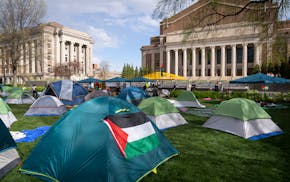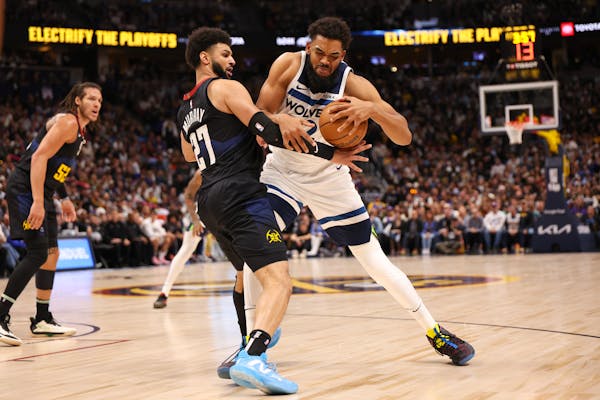Thank you, Star Tribune, for a red-letter day of high-caliber reader letters. I agree with this assessment of the illegal immigration problem: "The responsibility for economic conditions and providing for their citizens is still with those [foreign] governments" ("We cannot accept them all," March 23). Another writer said we need to do the "hard work of problem-solving" the conditions that made the people want to come here. Why does the U.S. need to solve other countries' problems? Is that not a patronizing, elitist, almost racist view — one that says people in other nations are so inept, incompetent and unimaginative they cannot solve their own problems? And the United States must do it for them?
These are not Syrian refugees, chemically attacked by their own president, nor displaced Yemenis, bombed and embargoed to starvation by the Saudis. These are citizens of countries that have more people than jobs and high crime in sections of their countries.
Along with that "only America can solve problems" mind-set is the assertion that anyone in less-than-ideal circumstances has a "right" to enter the United States. One reader in "A little perspective, please" (March 24) stated since our economy is bigger than Ecuador's, we should take all comers. Problems in other countries will never be solved if they adopt that "abandon ship" mentality. As pointed out in earlier letters, our social welfare system is already inadequate for our own citizenry. In contrast, European countries, which have rich social safety nets, have strict and enforced immigration controls. They see their first duty is to their citizens and cannot do everything for everyone.
Rob Meyer, Mendota Heights
• • •
While some letter writers advocate for greatly increased refugee admittance to the U.S., they overlook the fact that we already have over 10 million undocumented migrants in this country as well as a crisis in low-income housing and inequities in education and other sectors. We need to greatly increase investment in economic development, education and better governance in the refugee source countries on a scale similar to the Marshall Plan. Focusing our efforts on those who manage to make it to our borders does nothing to relieve the misery that brought them there and that continues to send more.
Les Everett, Falcon Heights
BEING WHITE AND MALE
Not all the same, but still privileged
Since I'm a 67-year-old white American male whose family history on this continent dates back to the 17th century, Michael Obstaz's essay "Not all white men are the same" (Opinion Exchange, March 25) caught my eye. I read it several times and can relate to many of the roles Obstaz lists. I have been bullied and have been the bully. I've lived through times not knowing how I would get my next meal and times where I worried about earning the highest gain on my investments. I have been the last picked in a neighborhood pickup game and the best player on the field. I've endured the loss of a spouse and the elation of finding true love again. I am a proud father and grandfather. I have rewarding work that is my passion, and I delight in every day. I am a very lucky man. But I believe I would not feel the same had I been born a person of color or of a different orientation other than heterosexual.
When I first heard the phrase "white privilege," I felt anger. It took me several years of study and reflection to understand that — because of my skin color, family history and socioeconomic background — I was born already "on base," to use a baseball metaphor. Any real competition I have faced in my life was with other white males. The rest of humanity must compete with themselves and us in this privileged category! For Obsatz to not recognize this is pure ignorance.
MICHAEL RIDDLE, Coon Rapids
• • •
As a stereotypical older white male I can't agree more that "all white men are not the same." Likewise, all Black and brown men, Asian men, Hispanic men, gay men, etc., are also not the same.
I believe that it's harder to hate someone "up close." When we begin to communicate and get to know each other, our hard-wired biases can be penetrated to the point where we see what's on the inside, rather than just the wrapper. What if the community planned some "come together days," let's call them? Perhaps some in north Minneapolis? Perhaps some in Edina? That would certainly be a conversation starter, wouldn't it?
Bruce Burton, Bloomington
CLEAN CAR RULES
You can still drive your gas-guzzler
Recent articles and comments about California clean car standards only being good for the climate are ill-informed. Much of the northeast United States has followed these rules for years.
When I lived in Vermont, I was able to register a car from North Dakota without any fuss and drive it alongside everyone else. Clean car standards didn't stop people owning everything from rusty old Subarus to full-size SUVs and trucks. Clean car standards didn't stop the snowplows. Clean car standards didn't stop high school seniors from driving to prom in vehicles that would have been at home at a monster truck rally or a Formula One race. They didn't prevent anyone from finding the automobile they wanted — all they did was help the rest of us breathe a little more easily around it by limiting emissions in newly manufactured vehicles.
Please, don't let the naysayers detract from the goal of keeping our air and environment healthy. These new clean car regulations would help make Minnesota a leader in the field and preserve the lakes and woods we all hold dear.
Sidler Davis, St. Paul
COVID VACCINES
An opportunity for further study
Though not unexpected, the news that a very small minority of people who have been fully immunized developed "breakthrough" COVID infections raises an issue of pursuing more science ("Tiny minority getting virus despite shots," front page, March 25). We continue to learn about this virus in unanticipated ways. Given that there are still many Minnesotans who have not been vaccinated, consider a study going forward: When people show up for their shot, ask for volunteers to agree to a nasal swab or saliva test to see if they are unknowingly infected at the time. Perhaps also ask for a blood test to look for antibodies. If they are receiving either the Pfizer or Moderna vaccine, repeat the procedure when they return for their second shot and maybe even a month after that. Search for variants. Follow outcomes and responses.
It's not necessarily a controlled study, but it would be reasonably easy to do and would help to both inform and guide when future questions undoubtedly occur.
Paul Waytz, Minneapolis
• • •
How lovely to see Catherine Watson's name in the Star Tribune again! ("Vaccine passports? They already exist," Opinion Exchange, March 23.)
When I got my second jab, I pulled out my yellow (very yellow, tattered and taped) international certificate of vaccinations booklet and handed it to the nurse and asked if she'd enter my two Covid vaccine doses in it. She said it looked like it had seen a lot of miles. I got mine in 1963 and like Catherine, I've have never been without it or my passport since. Many things stay home but these two items never leave my presence.
While there may not be travels anytime in my future, you just never know. I'm ready when they are, as is Catherine.
Jan Streiff, Cloverton, Minn.
We want to hear from you. Send us your thoughts here.
Store guns safely and save lives

Why we protested at the University of Minnesota


